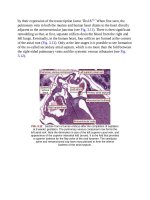Andersons pediatric cardiology 178
Bạn đang xem bản rút gọn của tài liệu. Xem và tải ngay bản đầy đủ của tài liệu tại đây (87.85 KB, 3 trang )
VascularProgramming
Thefetaloriginshypothesisproposesthatadaptationofthefetustoits
intrauterineenvironmentandpostnatalstressorsmayhavelife-long
consequencesandthatthefetalresponsetoanenvironmentalchallengemay
resultinprogrammingofdifferentorgans,dependingonthetimingoftheinsult.
Theoriginalconceptoffetalprogramminghasbeenexpandedandnow
encompassesbothprenatalandpostnataladaptationundertheumbrellaofthe
developmentaloriginsofadultdisease.Environmentalfactorscontributeto
permanenteffectsresultingfromalteredepigeneticandgeneticregulationthat
canbedemonstratedinpopulationstudies.218
VascularProgrammingintheSettingof
RestrictedGrowth
Thefetalcardiovascularsystemdiffersfromthatoftheneonateinthatthe
interdependencebetweencardiacandpulmonaryphysiologyislessimportant
thanthatoftheplacentalvasculature.Normalplacentaldevelopmentincludes
appropriatetrophoblasticinvasiontoremodelplacentalspiralarteriesandcreate
alowimpedancecirculation.Thisisimportantinthedevelopmentofnormal
fetalcardiovascularresponses.29Thisvascularchangedoesnotoccurincasesof
placentaldysfunction.Thereductioninplacentalflowmaythenresultina
growth-restrictedfetus.54,55Thefetusaltersitsadaptiveresponsestoenable
survivalintheseadverseconditions,sometimestothedetrimentoflater
functionalandadaptiveresponses.57Thesehavebeentermed“predictive
adaptiveresponses.”219Thismodelproposesthattheriskofdiseasedependson
thedegreeofmismatchbetweenthepredictedpostnatalenvironmentandthat
whichexists.Thepredictionusuallyanticipatesaworseoutcomethanexists,
whichfurtherincreasesthemismatch.Adverseearlyinfluencesarethoughtto
resultintheso-calledthriftyphenotype.Thisdescribesanindividualthatcan
matchsupplyanddemandsuccessfullytopermitsurvival,eventhoughsomeof
theadaptivemechanismsthisinvolvesmayleadtolaterdiseasethrough
disturbancesofnormalcardiovascularandneurohormonalcontrolmechanisms.
Postnatalnutritionoftenresultsincatch-upgrowthingrowth-restrictedinfants,
andthismayfurtherdisturbthe“thriftyphenotype,”permittinganindividualto
livewithinhisorherpredictedenvironment.
ManyDopplerultrasoundstudiesofthegrowth-restrictedfetushavebeen
published,and,morerecently,reportsproposethatcardiacdevelopmentitselfis
affected,thegrowth-restrictedfetushavinganincreasedsphericityindex
comparedwiththosethatarenormallygrown.39,40Thesefindingshavebeen
describedininfancy,andlong-termstudiesarerequiredtoassesstheirfuture
impactoncardiacfunction.Fetalstudieshavedescribedtheeffectsofincreased
systemicimpedance,duetoplacentaldysfunction,onthecirculatorysystem.
Thisresultsinanimpairmentofvenousflowtowardtheheartduringdiastole,
withaconsequentreductionofpeakvelocityofinwardflow61,62andareduction
inthepulsationsofthewalloftheinferiorcavalvein.Theincreasedcentral
venouspressuremaycontributetoimpairmentofsystemicvenousreturnanda
reductioninnormalforwardflowduringlatediastoleinthepulmonarytrunk.
Thissuggeststhatthereisabnormalveno-ventricular-vascularcoupling.220
Increasedshuntingthroughthevenousductingrowth-restrictedfetusesreduces
umbilicalbloodsupplytothefetalliver,whichmaybedetrimentalinthose
survivingwithrestrictedgrowth.221Occlusionofthevenousductleadstoa
significantincreaseincellproliferationinfetalskeletalmuscle,heart,kidneys,
andliverandpossiblytoanincreaseinexpressionofIgF1and2andmRNA.
Thesealterationsmayhaveasignificantlong-terminfluenceonmetabolismin
thegrowth-restrictedindividual,lendingsupporttotheconceptofaltered
metabolismseeninadultswithreducedbirthweight.222
Somestudieshavereportedareductioninsystolicvelocitiesthroughthe
arterialvalvesingrowth-restrictedfetuses.However,thisisnotauniversal
findinganddoesnotnecessarilyreflectpoorventricularfunction.Otherauthors
havereportedincreasedpeaksystolicvelocitiesofflowbutfoundthattheflow
commencedlaterinsystolethannormal,thusresultinginanincreased
preejectionperiodandashorterejectiontimebecauseoftheincreasedsystemic
impedance,resultinginareducedstrokevolume.223Cardiacoutputcorrectedfor
weightisnormalingrowth-restrictedfetuses,butthemeanvelocityofflowin
thedescendingaortaissignificantlyless,andthevolumeofbloodflowing
showedasimilar,butnonsignificanttrend,suggestingmoreisdirected
cephalad.220
Theeffectsofvascularprogrammingassociatedwithalteredintrauterine
nutritionmaynotbeobviousinindividualsstudiedearlyinlife.Although
componentpartsofthefetalarterialpulsewaveformaresignificantlydifferentin
thegrowth-restrictedfetus,nodifferenceshavebeenfoundinpulsewave
velocity.220Therelationshipbetweenpulsewavevelocityandintrauterine
growthrestrictionisnotyetclear,butinbabiesdeliveredatnormalterm,there
appearstobeaninverseassociationbetweenthevelocityoftheneonatalarterial
pulsewaveandmaternalsystolicbloodpressure,withapositiverelationshipfor
neonatalgestationalage,birthweight,length,andneonatalbloodpressure.224
Prematurityalonedoesnotappeartoinfluencethevelocityofthepulsewave.
Childrenbornpriortotermwithaz-scoreforbirthweightbelowminustwo
standarddeviationshadsignificantlyhighermeanbloodpressureandhigher
pulsewavevelocityatschoolagethanthosebornpriortotermbutofnormal
weight.225Longitudinalstudieshaveshownthatyoungadultsstudiedinfetallife
becauseofrestrictedgrowthhavesmalleraortasthancontrolsandhigherresting
heartrates,suggestingalteredcardiovascularmodulation.226Itmaybethat
maturationoftheaorticwallisrequired.Alternatively,aprocessof
amplification227mayneedtooccurduringinfancybeforeanydifferencescanbe
appreciatedinthepropertiesoftheaorticwall.Thefindingofincreasedarterial
wallthicknessiswidelyreportedingrowthrestrictedfetusesandbabies.228–230
Inadditiontoisolatedgrowthrestrictiontheresponseofthefetalendotheliumto
maternalhypertensionisimportantasgrowthrestrictionandpreeclampsiaare
closelycorrelatedandappeartobeassociatedwithelevatedbloodpressurein
childhood.231,232However,amorerecentstudyusingvery-high-frequencylinear
probesof35to55MHzreportsthatarterialwalllayer,lumendiameter,and
carotidarterywallstresswereattributabletosomaticgrowth,implyingtheuse
oflowerfrequencytransducersmayhaveoverestimatedwalllayer
measurementsofthickness.233
CardiovascularProgramminginTwin-Twin
TransfusionSyndrome
TTTSisanextrememodelofcirculatoryimbalanceoccurringinmonochorionic
pregnancieswheretherearetwogeneticallyidenticalindividuals.Within-pair
responsesinthecardiovascularresponsetodifferencesinvolumeloadandthe
effectofincreasedplacentalresistancecanbemeasured.Studieshaveconfirmed
thatfetalvascularprogrammingoccursandreducedarterialdistensibilityis
detectableinthegrowth-restricteddonortwinduringinfancy.234Furthermore,
theintertwindifferencesarealteredbyintrauterinelaserablationofplacental









